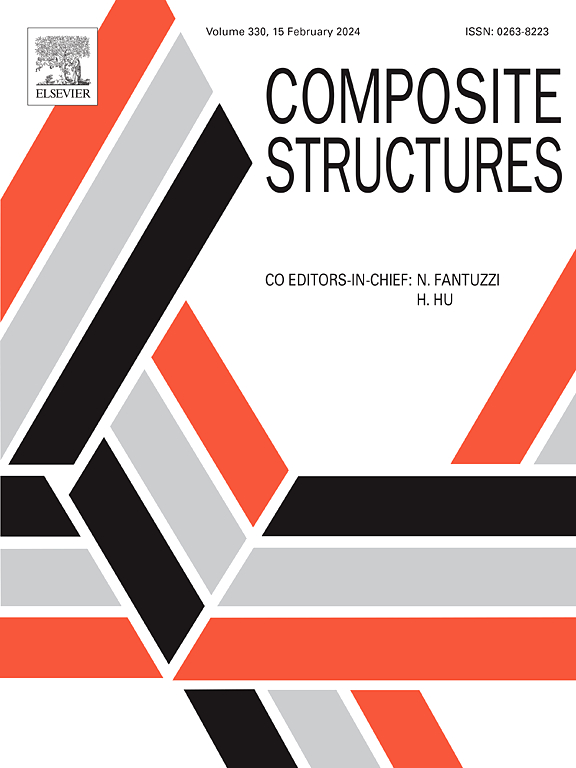用扩展微分正交法求解双曲面复合材料壳体的三维弹性问题
IF 6.3
2区 材料科学
Q1 MATERIALS SCIENCE, COMPOSITES
引用次数: 0
摘要
本文采用强采样面(SaS)公式对具有一般边界条件的双曲面复合材料壳体进行三维(3D)应力分析。SaS 方法基于选择平行于中间表面并位于切比雪夫多项式节点的 SaS,以引入这些表面的位移作为未知函数,这导致了一种非常规的壳公式,其中应变-位移和应力-应变关系用 SaS 位移表示。这是因为使用了拉格朗日多项式来近似厚度方向上的位移、应变和应力。外表面不包括在一组 SaS 中,因此可以均匀地最小化拉格朗日插值法的误差。强 SaS 计算方法是通过扩展微分正交(EDQ)方法对厚度方向上的弹性平衡方程进行直接积分,可以有效地应用于带夹紧和自由边缘的双曲面复合材料壳体的高精度计算。这是因为在 SaS/EDQ 公式中,SaS 的位移、应变和应力是在曲线坐标系中使用切比雪夫-高斯-洛巴托网格指定的矩形域中插值的,拉格朗日多项式也被用作基函数。所提出的方法以 SaS 应力处理平衡方程,避免了以 SaS 位移处理二阶微分方程的积分,从而大大简化了 EDQ 方法的实施。本文章由计算机程序翻译,如有差异,请以英文原文为准。
Three-dimensional elasticity solutions for doubly-curved composite shells by extended differential quadrature method
This paper presents the three-dimensional (3D) stress analysis of doubly-curved composite shells with general boundary conditions using the strong sampling surfaces (SaS) formulation. The SaS method is based on the choice of SaS parallel to the middle surface and located at Chebyshev polynomial nodes to introduce the displacements of these surfaces as unknown functions that leads to a non-conventional shell formulation, in which strain–displacement and stress–strain relationships are represented in terms of SaS displacements. This is due to the use of Lagrange polynomials in approximating displacements, strains and stresses in the thickness direction. The outer surfaces are not included into a set of SaS that makes it possible to uniformly minimize the error used by Lagrange interpolation. The strong SaS formulation, based on direct integration of elasticity equilibrium equations in the thickness direction by the extended differential quadrature (EDQ) method, can be applied efficiently for high-precision calculations of doubly-curved composite shells with clamped and free edges. This is because in the SaS/EDQ formulation, displacements, strains and stresses of SaS are interpolated in a rectangular domain specified in a curvilinear coordinate system using a Chebyshev-Gauss-Lobatto grid and Lagrange polynomials are also used as basis functions. The proposed approach deals with equilibrium equations in terms of SaS stresses, avoiding the integration of second order differential equations in terms of SaS displacements, that greatly simplifies the implementation of the EDQ method.
求助全文
通过发布文献求助,成功后即可免费获取论文全文。
去求助
来源期刊

Composite Structures
工程技术-材料科学:复合
CiteScore
12.00
自引率
12.70%
发文量
1246
审稿时长
78 days
期刊介绍:
The past few decades have seen outstanding advances in the use of composite materials in structural applications. There can be little doubt that, within engineering circles, composites have revolutionised traditional design concepts and made possible an unparalleled range of new and exciting possibilities as viable materials for construction. Composite Structures, an International Journal, disseminates knowledge between users, manufacturers, designers and researchers involved in structures or structural components manufactured using composite materials.
The journal publishes papers which contribute to knowledge in the use of composite materials in engineering structures. Papers deal with design, research and development studies, experimental investigations, theoretical analysis and fabrication techniques relevant to the application of composites in load-bearing components for assemblies, ranging from individual components such as plates and shells to complete composite structures.
 求助内容:
求助内容: 应助结果提醒方式:
应助结果提醒方式:


